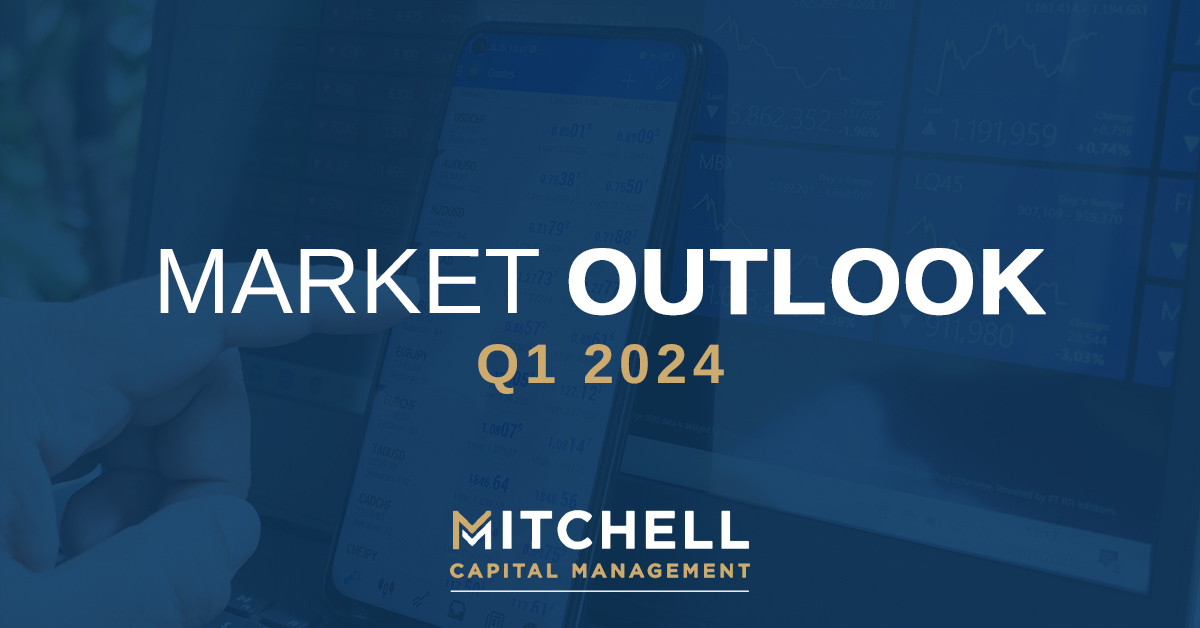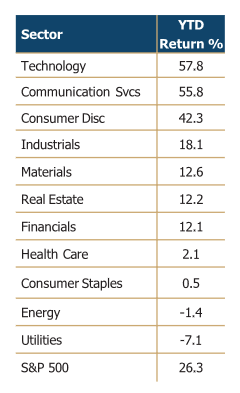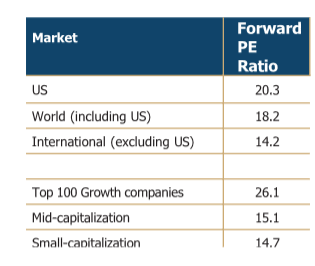
Equity Markets
Worldwide fourth-quarter equity markets advanced 11.1%, bringing 2023’s total return to 22.8%. The sharp rally ignited when the Federal Reserve held rates steady but acknowledged potential interest rate decreases in 2024, representing a major change in monetary policy, which had been, up to that point, a headwind as the Federal Reserve fought inflation. The timing of potential rate reductions is difficult to predict. Still, the stock market forecasts out a year, and we may be in a less restrictive monetary environment as we enter 2025. Market volatility is a given, so expecting some pullback after the fourth quarter run and a 1% decline in the 10-year US Treasury should be expected. Despite near-term volatility and the upcoming US elections, we expect worldwide markets to provide an average of 8% to 10% returns in 2024. Our global equity strategy remains overweight the US while investing in high-quality, market-leading international companies. Worldwide economic conditions remain mixed. The US continues to grow as job creation continues, and consumer spending remains solid. However, pockets of weakness developed in manufacturing, housing, transportation, and credit quality among lower-income households.

Europe has been adjusting to the Ukraine/Russia war, but the new conflict in Israel adds a negative development to international markets. The Red Sea is a major maritime trade route, so supply disruptions could cause inflation to trend higher as shippers use other, more expensive routes and increase rates. China’s economy is struggling with a more restrictive government, and years of companies moving some operations to other regions are taking a toll. Latin America is benefitting as one of the beneficiaries of redeployed manufacturing. Brazil and Chile anchor South America’s economy, but hyperinflation in Argentina persists.
Investment themes from 2023 included artificial intelligence, a banking crisis, war in the Middle East, and moderating inflationary pressures, all creating a narrow market regarding sector and individual security performance. Only three sectors led the overall market: Information Technology advanced by 57.8%, Communication Services by 55.8%, and Consumer Discretionary by 42.3%. All three were led by companies steeped in technology, such as Nvidia, Alphabet, Tesla, or Amazon, respectively. Two sectors declined, two were flat, and the others had solid but underperforming returns.
The table below shows that the returns combined with earnings growth led to forward PE (price to earnings) ratio disparities in worldwide markets and within market capitalizations.
The international markets normally trade at a valuation discount to the US market due to economic and political stability differentials. However, we are experiencing a wider-than-normal divergence between large-growth companies and mid/small-capitalization companies.
Fears over higher interest rates and a slowing economic expansion negatively impact mid and smaller companies by a larger amount as investors look for diverse geographical and customer-centric businesses.
As long-term interest rates stabilize within historical ranges and the potential for lower short-term interest rates materializes, we expect mid and small- capitalization prices to increase and PE ratios to close the gap. We’ve added several mid/small-capitalization companies over the last year and expect to add more in 2024.

Fixed Income Markets
Following rising rates for the first three quarters, the tone of bond markets wavered last quarter. Inflation continues to moderate due to the absence of additional pandemic-era, trillion-dollar fiscal stimulus and lower energy costs, with less credit given to the Fed’s rate increases. The result for the Fed is the gift of additional time and reduced political pressure. How it will utilize this window is the question before us.
The overnight rate increased in 2022 when the Fed raised it by 4.25%, leading to some of the worst bond portfolio losses in decades. The pace slowed in 2023 when overnight rates rose another 1.25% while inflation continued to moderate. Meanwhile, the 10-year US Treasury note yield increased too in fits and starts, reaching 5.0% on October 19, 2023.
Certain industries suffered. Housing transactions dropped as inventories shrank due to low coupon borrowers holding on to existing mortgages, and financing rates rose for buyers. Bank investment portfolios suffered valuation declines that put three out of business in March, leaving many others with much weaker credit profiles that are still concerning today.
But rate increases didn’t affect everyone equally. Unemployment remains near historic lows, and the economy continues to expand, growing 1.9% in 2022 and forecasted at 2.4% for 2023, not at all the recession and higher unemployment economists and investors expected in the face of rate increases totaling 5.5%. It has become clear that rate increases have yet to have the same effect on overall economic activity as in the past.
With inflation moderating and Fed rate increases pausing, bond investors went on a buying spree late in the quarter. Bond prices rose, and yields dropped following the mid-October peak, reflecting a growing belief that not only was the Fed finished raising rates for this cycle, but 2024 would see multiple rate decreases, an outlook supported by the Fed’s forecasts. The prevailing narrative says the Fed is on a ‘golden path’ to a soft landing for the first time since 1994. Count us skeptical.
How the Fed uses the next six months will determine its flexibility to address the next inflationary upswing. If it embarks on rate reductions in 2024, long-term risks could grow.
Math tells us we are unlikely to coast into the Fed’s 2% inflation target quickly or easily. CPI inflation measures have fallen during 2023 primarily due to the effects of food and energy, which comprise about 20% of the total. However, due to their volatility, these two groups are excluded from headline inflation figures to derive a more reliable ‘core’ inflation for setting policy. Through November, food prices rose 2.9% from last year, while energy prices dropped -5.4%. Another 20%, grouped as commodities, comprises smaller categories like apparel, new and used vehicles, and alcohol and tobacco products, whose prices have stayed the same over the last year.
The last group, Services, is the biggest and the most consequential, covering 60% of total CPI and increasing 5.5% over the previous year through November. Shelter represents a majority of Services inflation, and prices in that group are growing 6.5% annually with little supply relief to address the country’s underinvestment in housing stock. Assuming no change in Services inflation, the remaining price inputs would need to decrease by an unlikely -3.2% to reach the Fed’s 2.0% inflation target. The only groups with declining prices are energy, used cars, and trucks, all highly volatile. A third, medical care, which declined 6% in 2023, is set to rise 6% in 2024. Inflation isn’t done with us yet.
Suppose the Fed lowers rates in 2024 before inflation returns to its target. In that case, it risks the effects of a shock to the system, which happens with sufficient regularity, many of which could carry inflationary pressures and upset the status quo. With regional wars in Eastern Europe and the Middle East, it’s no stretch to imagine another oil supply disruption driving prices higher and forcing a costly reorientation of production and distribution channels. Changing trade policies could result in additional tariffs and associated costs between the US and China, or Europe. It could be an adverse effect of heavy US Treasury borrowing, further testing the boundaries of bond buyers’ willingness to buy its debt without higher yields in return.
If we broaden our view to consider the longer-term, interest rates are not high. Instead, they are back to normal after being kept far too low for far too long.

